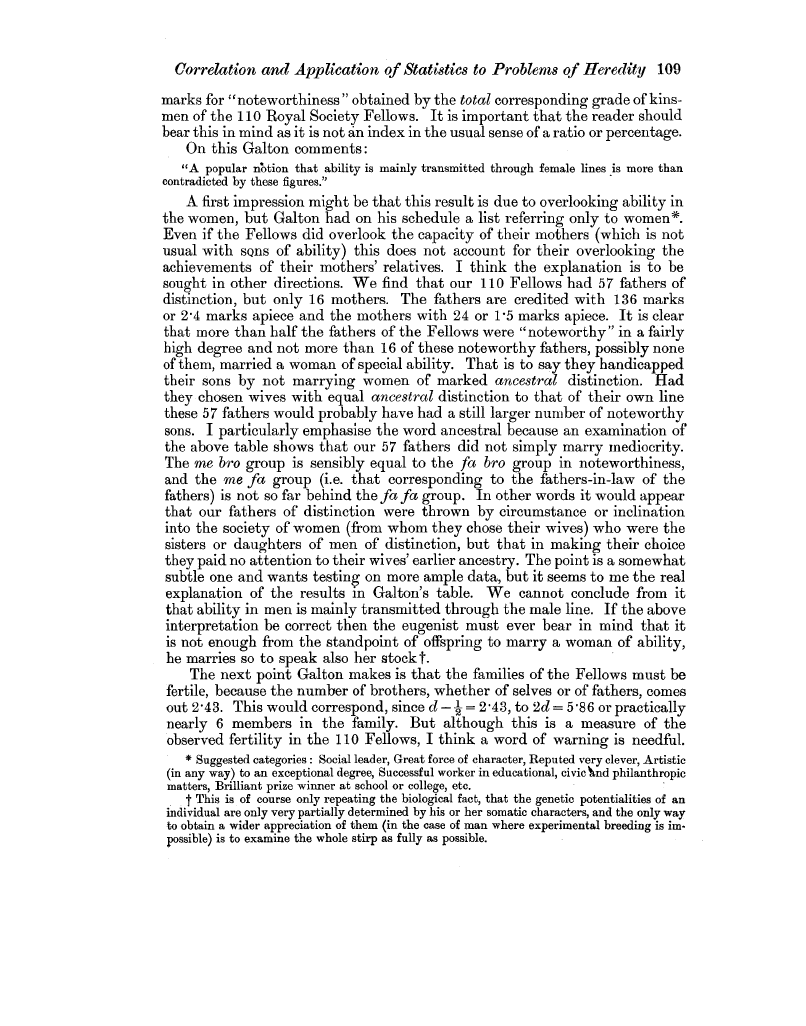| ||||||

OCR Rendition - approximate
Correlation and Application of Statistics to Problems of Heredity 109 marks for "noteworthiness" obtained by the total corresponding grade of kinsmen of the 110 Royal Society Fellows. It is important that the reader should bear this in mind as it is not an index in the usual sense of a ratio or percentage. On this Galton comments "A popular notion that ability is mainly transmitted through female lines is more than contradicted by these figures." A first impression might be that this result is due to overlooking ability in the women, but Galton had on his schedule a list referring only to women*. Even if the Fellows did overlook the capacity of their mothers (which is not usual with sQns of ability) this does not account for their overlooking the achievements of their mothers' relatives. I think the explanation is to be sought in other directions. We find that our 110 Fellows had 57 fathers of distinction, but only 16 mothers. The fathers are credited with 136 marks or 2.4 marks apiece and the mothers with 24 or 1.5 marks apiece. It is clear that more than half the fathers of the Fellows were "noteworthy" in a fairly high degree and not more than 16 of these noteworthy fathers, possibly none of them, married a woman of special ability. That is to say they handicapped their sons by not marrying women of marked ancestral distinction. Had they chosen wives with equal ancestral distinction to that of their own line these 57 fathers would probably have had a still larger number of noteworthy sons. I particularly emphasise the word ancestral because an examination of the above table shows that our 57 fathers did not simply marry mediocrity. The me bro group is sensibly equal to the fa bro group in noteworthiness, and the me fa group (i.e. that corresponding to the fathers-in-law of the fathers) is not so far behind the fa fa group. In other words it would appear that our fathers of distinction were thrown by circumstance or inclination into the society of women (from whom they chose their wives) who were the sisters or daughters of men of distinction, but that in making their choice they paid no attention to their wives' earlier ancestry. The point is a somewhat subtle one and wants testing on more ample data, but it seems to me the real explanation of the results in Galton's table. We cannot conclude from it that ability in men is mainly transmitted through the male line. If the above interpretation be correct then the eugenist must ever bear in mind that it is not enough from the standpoint of offspring to marry a woman of ability, he marries so to speak also her stock t. The next point Galton makes is that the families of the Fellows must be fertile, because the number of brothers, whether of selves or of fathers, comes out 2.43. This would correspond, since d - 2 = 2.43, to 2d = 5.86 or practically nearly 6 members in the family. But although this is a measure of the observed fertility in the 110 Fellows, I think a word of warning is needful. * Suggested categories : Social leader, Great force of character, Reputed very clever, Artistic (in any way) to an exceptional degree, Successful worker in educational, civicland philanthropic matters, Brilliant prize winner at school or college, etc. j' This is of course only repeating the biological fact, that the genetic potentialities of an individual are only very partially determined by his or her somatic characters, and the only way to obtain a wider appreciation of them (in the case of man where experimental breeding is impossible) is to examine the whole stirp as fully as possible.
|